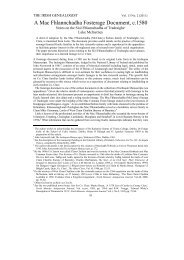Report Cover Vol I - Clare County Library
Report Cover Vol I - Clare County Library
Report Cover Vol I - Clare County Library
Create successful ePaper yourself
Turn your PDF publications into a flip-book with our unique Google optimized e-Paper software.
The <strong>County</strong> <strong>Clare</strong> Wetlands Survey Patrick Crushell & Peter Foss 2008<br />
____________________________________________________________________________________<br />
8.3 <strong>Clare</strong> Wetland Survey Recommendations<br />
From the results of the <strong>County</strong> <strong>Clare</strong> Wetlands Study the following recommendations in relation to future<br />
surveys, additional data acquisition and project development are suggested:<br />
1. Both datasets should be maintained and updated regularly. Additional sources of information on<br />
wetlands in <strong>County</strong> <strong>Clare</strong> should be incorporated into them as these become available. Appendix 1 details<br />
reports which may contain additional wetland information which were not examined as part of this<br />
project. In addition NPWS are likely to produce additional detailed habitat maps of sites (i.e. NHAs, SACs<br />
and SPAs) which should be incorporated into the CWS dataset.<br />
2. The CWS GIS and site database provides a useful reference source on the identification of sites for<br />
future wetland survey in <strong>County</strong> <strong>Clare</strong> and should be developed further. A significant number of sites<br />
have been identified for which site boundaries, and detailed survey information and associated<br />
habitat maps is lacking. These sites should be examined as part of any future <strong>County</strong> <strong>Clare</strong> wetland<br />
field survey. Clusters of these sites occur especially in the south western part of the county, (between<br />
Inagh, Cooraclare and Kilmurry) and the eastern part of the county (between Tulla, Broadford and<br />
Scarriff).<br />
3. A number of wetland habitat types have been identified in <strong>County</strong> <strong>Clare</strong>, for which habitat data,<br />
information on habitat extent, site boundaries and conservation status is lacking in many cases. These<br />
should be a priority for surveyed as part of the ongoing development of a wetland inventory for the<br />
county. These habitats include: turloughs, rich fen and flush, tall herb swamp, spring sites and<br />
wet grassland (see Table 8.1).<br />
4. Within the CWS GIS a number of wetland sites have been newly identified for which habitat data is<br />
currently rather rudimentary. These should be surveyed to improve our knowledge of this resource, in<br />
terms of the habitat types and extent present and assess their potential as conservation worthy areas.<br />
5. Future phases of the CWS should aim to provide the following information on the wetland sites being<br />
surveyed:<br />
• A detailed site description highlighting the wetland habitat types (classified according to Fossitt)<br />
present on each site;<br />
• Detailed mapping of the extent of each of the wetland type(s) within each site;<br />
• Mapping of general site boundaries of the overall site to ensure conservation of a hydrologically<br />
intact unit;<br />
• Recording of threats to the conservation and future protection of the site; to include restoration<br />
suggestions and management priorities and needs;<br />
• Evaluation of each site on a national scale and ranking of each site in terms of its suitability and<br />
priority for designation within the NHA and/or SAC process.<br />
6. The following habitats should be targeted and prioritised in any future surveys: fens, turloughs,<br />
lakes and springs. In addition, previously unsurveyed sites recorded during the course of the CWS<br />
should be prioritised for survey (see Table 8.1).<br />
7. The protection of <strong>Clare</strong>’s diverse wetland resource depends on strict enforcement of national<br />
conservation legislation by the NPWS, and planning laws to ensure unauthorised damaging activities<br />
(such as those identified during the CWS) are prevented.<br />
8. Restoration of threatened and degraded wetland habitats should be encouraged such as the heavily<br />
degraded and unique raised bogs of south <strong>Clare</strong>, and the highly modified blanket bogs of the upland<br />
areas where forestry has caused significant losses. Funding opportunities for such initiatives should be<br />
investigated and pursued.<br />
9. A public awareness campaign should be undertaken to inform the people of <strong>Clare</strong> of the value of<br />
the county’s wetland resource and the ecosystem services they provide.<br />
10. A standard methodology / approach should be developed by the Heritage Council for Phase I desk<br />
based wetland surveys that may be undertaken in the future throughout Ireland. The methodology used<br />
during the CWS could be refined further and improved upon to provide a useful template.<br />
70
















